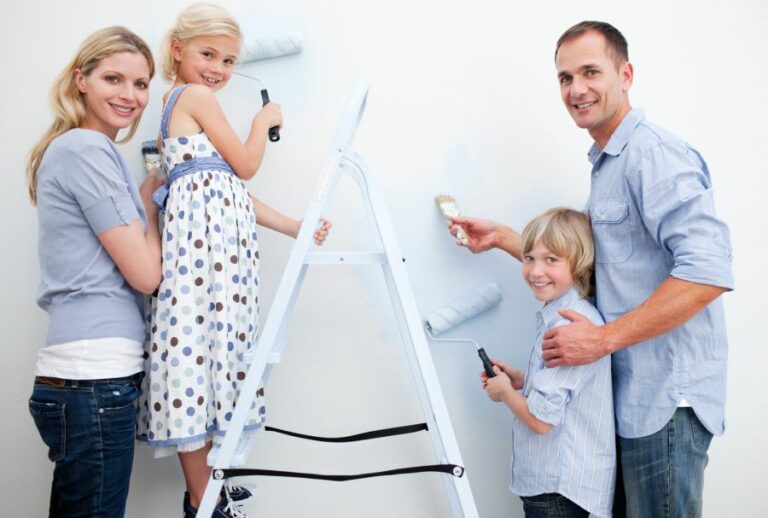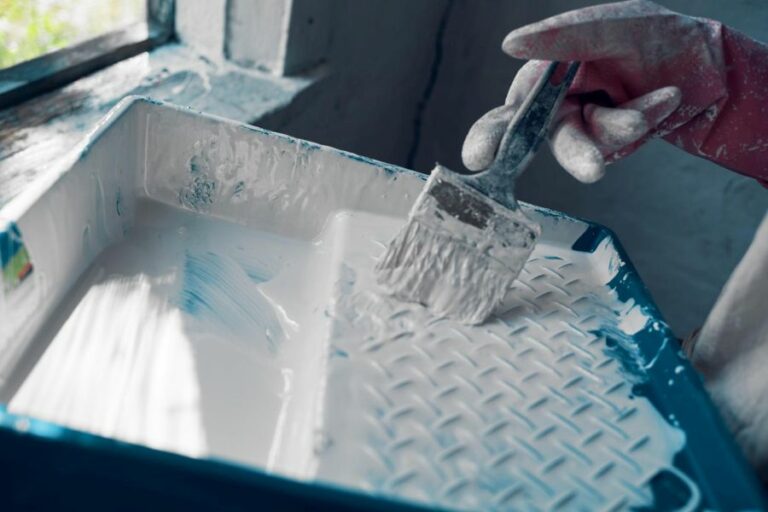Start Painting Indoors With Prep Work
Are you ready to unleash your creativity and transform your indoor spaces with a fresh coat of paint? I’m here to guide you through the essential prep work that will ensure a smooth and successful painting experience. With these foolproof tips and techniques, you’ll be well-equipped to bring your artistic vision to life, starting with thorough preparation and paving the way for a fabulous finish.
Start painting indoors with prep work:
First, to start painting indoors, gather essential tools like paint, brushes, rollers, and drop cloths. Choose the right paint type, usually water-based, for indoor projects, and prepare the surface by cleaning, repairing, and sanding it. Apply a primer if necessary, protect your space with painter’s tape, and use proper painting techniques for a professional finish.

Ready to transform your living space with a fresh coat of paint? Master the art of indoor painting with these essential prep tips, from choosing the right paint to prepping your walls. Read on and get ready to transform your home!
Contents
- 1 Indoor Painting: Preparation Guidelines
- 2 Preparing for Interior Painting: Top Tips
- 3 Beginning Your Home Interior Painting Project
- 4 Key Preparation Steps for Home Painting
- 5 First Steps for Painting a Room: Where to Begin
Indoor Painting: Preparation Guidelines
Painting indoors can be a fun and rewarding experience, but proper prep work is essential for a professional-looking result. Follow these steps and recommendations to ensure your indoor painting project is a success.
• Gather Your Tools
Before you start painting, gather all the necessary tools and supplies. Some essential items include:
- Paint
- Brushes
- Rollers
- Paint trays
- Painter’s tape
- Drop cloths
- Ladders
- Sandpaper
- Cleaning supplies
- Old clothes or paint clothes
In addition to these basic items, you may also want specialized tools such as a paint edger, corner brush, or extension pole. Make sure you have everything you need before starting your project.
• Choose the Right Paint
To achieve the best results when painting indoors, selecting the appropriate paint is crucial. There are two main types of interior paint: water-based and oil-based. Here are some factors to consider when choosing between the two:
- Water-based paint: Often referred to as latex paint, water-based paint is typically easier to work with and dries faster. It also has lower levels of volatile organic compounds (VOCs), making it a more environmentally friendly option.
- Oil-based paint: This type of paint is more durable and long-lasting, making it suitable for high-traffic areas such as kitchens and bathrooms. However, it takes longer to dry and has higher VOC levels.
For most indoor painting projects, water-based paint is recommended. Be sure to choose high-quality paint that will provide good coverage and resist wear over time.
• Prepare the Surface
A well-prepared surface is key to a professional and lasting paint job. Follow these steps to prepare your walls:
– Clean
Begin by thoroughly cleaning the walls to be painted. This can be done using a mixture of mild soap and water. For more stubborn dirt or grease stains, consider using a specialized wall cleaner or degreaser.
– Repair
Examine the walls and look for any damage, such as cracks, holes, or dents. Small imperfections can be filled with a pre-made patching compound, while larger holes may require drywall tape and joint compound.
For cracks, use a utility knife to remove any loose material, then fill with patching compound and smooth the surface with a putty knife. Once the compound is dry, sand the area with fine-grit sandpaper until it is smooth and even with the surrounding wall.
– Sand
After repairing any damages, gently sand the entire surface to be painted with fine-grit sandpaper. Sanding will help the new paint adhere to the surface and create a smoother, more professional-looking finish.
– Prime
Priming is an essential step when painting over dark colors, new drywall, or when changing from oil-based to water-based paint. Choose a high-quality primer that’s compatible with your chosen paint, and apply a thin, even coat according to the manufacturer’s instructions.
• Protect Your Space
Before you begin painting, take the time to protect your space from paint splatter and spills. Remove or cover any furnishings, lay down drop cloths or plastic sheeting, and use painter’s tape to cover baseboards, trim, and other surfaces that should not be painted.
• Painting Techniques and Tips
Now that your space is prepared, it’s time to start painting. Here are some expert painting techniques and tips to ensure a professional finish:
– Cutting In
Rather than starting with a roller, use a brush to “cut in” the edges and corners of the room. This prevents roller splatter on other surfaces and helps create a clean, crisp edge.
– Rolling
When applying paint with a roller, use long, even strokes in a “W” pattern. This ensures even coverage and helps avoid streaking. Remember always to keep a wet edge and work in small sections so the paint doesn’t dry before you can roll over it.
– Proper Loading
Don’t overload your brush or roller with paint. Instead, dip your brush only halfway into the paint, then tap off the excess. For rollers, use a paint tray or screen to distribute the paint on the roller evenly.
– Multiple Coats
Most painting projects require at least two coats of paint for even coverage and a professional look. Wait for the first coat to dry according to the manufacturer’s instructions before applying the second coat.
• Clean Up and Maintenance
After completing your indoor painting project, carefully remove painter’s tape, drop cloths, and other protective materials. Clean paintbrushes, rollers, and other tools with warm, soapy water.
To maintain your newly painted surfaces, use a damp cloth to remove dust or dirt as needed gently. Protect the paint job by avoiding abrasive cleaners or harsh chemicals.
By following these expert prep work and painting tips, you’re sure to achieve professional results on your next indoor painting project. For further information on indoor painting best practices, visit the United States Environmental Protection Agency’s website for guidelines on lead-safe painting practices.
Preparing for Interior Painting: Top Tips
Painting the interior of your house can be a highly rewarding DIY project. However, it involves more than just picking up a brush and applying a coat of paint. A poorly prepped surface can lead to less-than-ideal results, like peeling and uneven coverage.
Taking the time to prepare your walls, floors, and furnishings can ensure a successful end product that lasts for years. Here are the essential steps to prepare your home for a smooth, attractive, and long-lasting paint job.
• Choosing the Right Materials
– Selecting the Paint
Picking the right paint for your project is crucial. Consider the finish matte, eggshell, satin, semi-gloss, or gloss that will best suit your needs. Each finish has its pros and cons, and some are better suited for specific rooms or surfaces.
- Matte Finish: This non-reflective finish is great for hiding surface imperfections but scuffs easily. It’s ideal for low-traffic areas like bedrooms and ceilings.
- Eggshell Finish: This low-sheen finish is more durable and easier to clean than matte, making it suitable for moderate-traffic areas like living rooms and hallways.
- Satin Finish: This medium-sheen finish is perfect for high-traffic areas, like kitchens and bathrooms, due to its durability and washability.
- Semi-gloss Finish: This shiny finish is excellent for doors, trim, and cabinetry because it’s durable and easy to clean. It highlights surface imperfections, so proper wall prep is crucial.
- Gloss Finish: This highly reflective finish is best for surfaces that need to be regularly washed, such as doors and cabinetry. It highlights surface imperfections and may take longer to dry.
To determine the amount of paint you’ll need, calculate the square footage of each wall or surface (height x width) and consult a paint calculator for an accurate estimate.
– Choosing Brushes and Rollers
Using the right brushes and rollers will make your painting process smoother and faster. Select the appropriate size and material for your job:
- Brushes: For walls and ceilings, a 2.5- to 3-inch angled brush works best. For trim and detail work, use a 1- to 2-inch brush.
- Rollers: Pick a roller with the right nap length to work with your chosen finish. A 3/8-inch nap is suitable for smooth surfaces, while a 1/2-inch nap works well for semi-smooth surfaces like textured drywall. A longer nap, such as 3/4-inch, is ideal for rough surfaces like stucco.
• Room Preparation
– Remove Furniture and Fixtures
Start by removing as much furniture as possible from the room to give yourself ample working space. For items that can’t be removed, cover them with plastic drop cloths. Remove any wall fixtures, like switch plates, outlet covers, and picture hangers, and store them safely.
– Protect the Floors
Cover the entire floor surface with heavy-duty drop cloths, such as canvas or plastic, to protect them from paint splatters and spills. Secure the drop cloth edges with painter’s tape to prevent tripping hazards and to keep the cloth in place.
• Wall Preparation
– Clean the Walls
Dirt, grease, and dust can prevent your paint from adhering correctly. Use a sponge or cloth and a mixture of water and mild detergent to clean your walls gently. Pay special attention to high-touch areas, like around light switches and door handles.
– Repair Damaged Areas
Inspect your walls for any cracks, holes, or dents. Fill smaller imperfections with a pre-mixed spackling compound, then sand the area smoothly. For larger holes or cracks, use a joint compound or a patching kit for a more robust repair.
– Sand the Surfaces
Sanding your walls ensures a smooth surface for your paint to adhere to. Using a pole sander or a fine-grit sanding block (120- to 150-grit), lightly sand the entire wall surface. Wipe the walls with a damp cloth to remove any dust after sanding.
– Prime the Walls
Priming your walls creates a uniform surface for your paint to adhere to, ensuring a more even finish. Ensure the primer you choose is compatible with your paint type (oil-based or water-based). Apply the primer using a brush for the edges and a roller for larger areas.
Allow the primer to dry according to the manufacturer’s instructions, typically 24 hours.
• Masking and Tape Application
Apply painter’s tape along baseboards, trim, door frames, and any other areas you want to protect from paint. Take the time to ensure a clean, straight edge for a professional-looking paint job.
• Final Preparations
Before you begin painting, gather all your materials and tools, including your paint, brushes, rollers, extension poles, and a ladder if needed. Stir the paint thoroughly to ensure consistent color, and transfer some of your paint into a smaller container or paint tray for easy application.
Following these steps will help guarantee a successful, long-lasting, and professional-looking paint job in your home. With proper preparation and attention to detail, you’ll be rewarded with beautiful, freshly painted walls to enjoy for years to come.
Step | Description |
|---|---|
1. Clear the Room | Remove furniture, decorations, and other items that could be damaged or get in the way of painting. |
2. Clean the Walls | Using a damp cloth or sponge, wipe down walls to remove dust, dirt, and other contaminants that could affect paint adhesion. |
3. Repair Wall Imperfections | Fill small holes and cracks with spackling compound and sand the area smoothly once it dries. |
4. Tape off Fixtures and Trim | Use painter’s tape to protect door and window trim, baseboards, and other fixtures that you don’t want to get paint on. |
5. Prime the Walls | Apply a coat of primer to ensure even paint coverage and help the new paint adhere better to the walls. |
6. Stir the Paint | Stir the paint to make sure it’s properly mixed and there are no lumps or inconsistencies in color. |
Beginning Your Home Interior Painting Project
• Preparing for the Task
– Create a Plan
Before you begin, it’s essential to create a plan of action. Decide which rooms and walls need to be painted, and make a list of the tools and materials you will require. Consider factors such as:
- The size of the rooms
- The type of paint and finishes you want to use
- Any furniture or items that need to be moved or protected
When choosing a paint color, consider the mood you want to create, the level of lighting in the room, and the room’s size. Lighter colors can create a sense of spaciousness, while darker colors can make a room feel cozy and intimate. This guide from Better Homes and Gardens can help you choose the right color scheme for your space.
– Gather Tools and Materials
To begin painting the inside of your house, gather the essential tools and materials, including:
- Paint
- Paintbrushes
- Paint rollers
- Paint trays
- Drop cloths
- Painter’s tape
- Ladders and step stools
- Screwdrivers (to remove outlet covers and light switch plates)
- Protective gear, such as goggles and gloves
It’s always a good idea to do some research on the specific type of paint you plan to use, as some paints may require additional supplies or special techniques for application.
• Prep the Room
– Clear and Protect Furniture and Floors
Before you start painting, remove any items that might get in your way or be damaged by paint spills or splatters. If you’re unable to move the furniture out of the room, move it to the center and cover it with a large drop cloth. Be sure to cover the floor with drop cloths to protect it from paint as well.
– Clean Walls and Baseboards
The next step is to clean your walls and baseboards thoroughly. Removing dust, dirt, and debris from the surface will ensure a smooth and even paint finish. You can use a simple solution of warm water and mild soap or a specialized cleaning product designed for walls.
– Repair Wall Imperfections
Before painting, check the walls for any cracks, holes, or other imperfections that need repair. Fill small holes or cracks with a spackling compound or lightweight filler; larger repairs may require drywall tape and joint compound.
Give the repairs ample time to dry before sanding them lightly to ensure a smooth finish.
– Apply Painter’s Tape
Painter’s tape is essential for achieving clean edges and protecting surfaces such as trim, baseboards, and outlet covers from paint. Apply the tape to any surface you don’t want to be painted, pressing it firmly to prevent the paint from bleeding under the edges.
• Begin the Painting Process
– Prime the Walls
Applying a primer coat is crucial for achieving a professional finish, especially if you’re painting over a darker color or covering stains. Primer helps create a smooth and even surface for the paint to adhere to, resulting in a longer-lasting paint job. Allow the primer to dry completely before proceeding.
– Cut in Edges
When you’re ready to paint, start by “cutting in” the edges. This term refers to painting the corners, trim, and other areas that can’t be reached with a roller. Use a high-quality, angled paintbrush to achieve clean, precise lines.
– Roll the Walls
Once you’ve cut in, it’s time to paint the walls using a roller. Begin by applying paint to the center of the wall, then work your way outward in a “W” or “M” pattern, ensuring that you maintain a wet edge to avoid lap marks.
Apply even pressure, and don’t overload the roller with paint to avoid drips and uneven coverage.
– Apply Multiple Coats
Apply at least two coats of paint for a professional finish, allowing adequate drying time between coats (usually about 24 hours, but check the manufacturer’s recommendations). This will help achieve even coverage and rich, vibrant color.
– Remove Painter’s Tape
When the final coat is dry, carefully remove the painter’s tape while pulling it away at a 45-degree angle. If you encounter any resistance, use a utility knife to score the tape gently to minimize the risk of pulling off paint.
• Final Touches
- Reinstall outlet covers, light switch plates, and any hardware you removed prior to painting.
- Survey the room for any touch-ups or clean-up needed, such as paint spills or drips that need to be scraped or wiped away.
- Rearrange your furniture and decor, ensuring that the paint is dry before placing items in contact with the walls.
• Conclusion
Painting the inside of your house can be a rewarding endeavor that refreshes your living space and increases your home’s value. By following this comprehensive guide, you’ll be well-equipped to tackle the project efficiently and expertly, with results that you’ll be proud of for years to come.
Step | Description |
|---|---|
1 | Choose the paint color and finish. |
2 | Calculate the amount of paint needed. |
3 | Purchase the necessary materials and tools (paint, brushes, rollers, trays, drop cloths, painter’s tape, etc.). |
4 | Allow the paint to dry per the manufacturer’s instructions, and apply a second coat if necessary. |
5 | Clean the walls and baseboards with a mild detergent and water mixture to remove dirt, dust, and grease. |
6 | Apply painter’s tape around windows, doors, and any fixtures to protect them from paint. |
7 | Start with cutting in (painting the edges) using a brush, beginning at the top of the wall near the ceiling and going down towards the baseboard. |
8 | Use a roller to paint the remaining large surfaces, working in “W” or “M” shaped patterns for even coverage. |
9 | Allow the paint to dry per the manufacturer’s instructions, and apply a second coat if necessary. |
10 | Remove painter’s tape and clean any spills or drips. Allow paint to dry completely before replacing furniture in the room. |
Key Preparation Steps for Home Painting
The right preparation before painting can ensure a smooth and professional finish and can extend the life of your paint job.
• Choose the Right Paint and Supplies
- Select the Right Paint Type: Choosing the right paint type for your project is essential. The two primary types of paint are water-based latex paints and oil-based alkyd paints. Water-based latex paints are commonly recommended for their ease of application, quick drying time, and simple soap and water clean-up. Oil-based alkyd paints are more durable but take longer to dry and require solvents for clean-up. In a majority of cases, latex paints are the best option for interior and exterior painting projects.
- Quality Matters: It is strongly recommended to invest in high-quality paint. Higher-quality paints provide better coverage, last longer, and exhibit greater resistance to fading, peeling, or chipping. Check the label for paint performance certifications like MPI ratings, Green Seal GS-11, or Environmental Protection Agency (EPA) VOC standards.
- Choose the Right Sheen: Paint sheen refers to the glossiness of the finish. Common sheen choices are flat or matte, eggshell, satin, semi-gloss, and high-gloss. The choice of sheen depends on your desired appearance as well as the room’s purpose and type of surface. Consider your specific needs, such as washability or resistance against stains and moisture.
• Surface Preparation
- Inspect Walls and Ceilings: Carefully inspect walls and ceilings for damages such as peeling, cracks, holes, or mildew. Addressing these issues beforehand will result in a smoother, even finish.
- Clean Surfaces: Cleaning will remove dirt, grease, grime, and other debris from the surface, ensuring better paint adhesion. A simple solution of detergent and water can be used to clean most surfaces. After cleaning, rinse with water to remove any residue and let the surface dry thoroughly.
- Repair Cracks and Holes: Use a putty knife or a patching compound to fill in any cracks, nail holes, or dents in the walls. After the compound has dried, use sandpaper to smooth the repaired areas.
- Treat Mildew and Mold: It is crucial to treat any existing mold and mildew before applying paint. Use a mixture of bleach and water (a ratio of 3 parts water to 1 part bleach) to clean the affected areas, following the necessary safety precautions. Rinse the surface with water and allow it to dry thoroughly.
- Sanding: Rough or uneven surfaces should be smoothed using sandpaper, ensuring a better paint job. Sanding the surface, especially when dealing with glossy paints, will help the new paint adhere more effectively.
- Priming: A primer is essential to create a uniform and consistent surface for the paint. Primer can help in covering stains or marks, provide better adhesion, and ultimately extend the life of your paint job.
• Protecting Your Space
- Remove Furniture and Coverings: Clear the room of furniture, curtains, and wall fixtures to make the painting process smoother and avoid damage to your belongings. Cover floors and remaining furniture with drop cloths or plastic sheeting to protect against spills and splatters.
- Tape the Edges: Use quality painter’s tape around doors, windows, and trim to create a clean edge and protect surfaces that are not intended for painting.
- Ventilation: Proper ventilation is essential for maintaining good indoor air quality during and after painting. Open windows and doors to promote airflow and minimize paint fumes, which can pose health risks.
• Application Tips
- Paint in the Proper Order: To achieve a professional finish, paint the room in the following order: ceilings, walls, doors, windows, and trim.
- Maintain a Wet Edge: Maintain a wet edge while painting to avoid lap marks and uneven coverage. Work in smaller sections and overlap painting strokes to ensure consistency in appearance.
- Use the Right Tools: High-quality brushes, rollers, and other painting tools will result in a more even and professional-looking finish. Match the brush and roller nap (the thickness of the roller’s fabric) to the paint type (latex or oil-based) and surface texture to achieve the best results.
- Allow Adequate Drying Time: Allow the paint to dry thoroughly between coats to ensure consistent coverage and to avoid peeling or bubbling. Always refer to the paint manufacturer’s recommendations for drying times and application instructions.
By following these expert recommendations for prep work before painting, you can achieve a professional, long-lasting finish that enhances your space with a beautiful and durable transformation.
Step | Description |
|---|---|
1. Clean the surfaces | Remove dirt, dust, grease, and other contaminants from the surfaces to be painted. |
2. Repair damage | Fill holes, cracks, and other imperfections with appropriate materials like wood filler, plaster, or spackling compound. |
3. Sand and smooth | Sand the repaired areas and the entire surface to create a smooth and even base. |
4. Prime the surface | Apply a coat of primer to ensure proper paint adhesion and to cover any stains, repairs, or darker colors. |
5. Tape and protect | Use masking tape and plastic sheeting to protect areas not being painted, such as windows, doors, and trim. |
6. Choose the right paint | Select the appropriate type and finish of paint for the surface and desired outcome. |
First Steps for Painting a Room: Where to Begin
As an expert in the field of painting and interior design, I’ve been asked this question many times: “When painting a room, what do you start with first?” While opinions may vary, there is a general order that most professionals follow.
• Gathering the Necessary Materials
Before you even start to think about the painting process, you need to gather all the materials you’ll need to get the job done right. This includes:
- Paintbrushes (both angled and flat)
- Paint rollers and extension poles
- Paint trays and liners
- Ladder
- Drop cloths or plastic sheeting
- Painter’s tape
- Sandpaper and sanding sponges
- Spackle and putty knives
- Screwdrivers and other tools for removing outlet covers and switch plates
- Clean, damp rags
• Choosing the Right Paint for the Job
Once you have all of your materials assembled, it’s crucial to select the right paint for your project. This involved considering factors like:
- Coverage: High-quality paints typically offer better coverage than their cheaper counterparts, meaning you’ll be able to achieve a more even coat in fewer applications.
- Sheen: The sheen of the paint can dramatically alter the appearance of a room. Flat or matte paints are ideal for concealing imperfections in walls, while glossier sheens provide a more reflective surface that’s easier to clean.
- Color: Selecting the perfect color for your room may seem like an overwhelming task, but utilizing paint swatches and sample cans can be extremely helpful in making your decision.
For more information on finding the right paint for your project, you might consider browsing resources from organizations like the Paint Quality Institute, which offers a wealth of information on paint types, sheens, and colors.
• Prepping the Room for Painting
To ensure the best possible outcome, it’s important to prepare the room before diving into the painting process. This involves a series of steps that include:
1. Clearing the Space
Remove all furniture, decorative items, and wall hangings. Any remaining items should be grouped together in the center of the room and covered with drop cloths or plastic sheeting.
2. Repairing Walls
Inspect the walls for any holes, cracks, or other imperfections that need to be repaired prior to painting. Patch these areas with spackle or joint compound, and gently sand the surface smooth once dry.
3. Cleaning the Walls
To ensure proper adhesion of the paint, it’s crucial to clean the walls thoroughly. Wipe down the entire surface with a damp cloth or sponge, and allow it to dry completely.
4. Taping Off and Covering
Apply painter’s tape along baseboards, trim, and other surfaces you wish to protect from paint splatters. Be sure to press the tape down securely to prevent any bleeding or seepage.
• The Painting Process: Where to Begin
When it comes to the actual painting process, most professionals agree that the following sequence should be followed:
1. Start With the Ceiling
Since gravity will cause any paint drips to fall downward, it only makes sense to begin with the ceiling. This will allow you to fix any mistakes or drips that may occur on the walls before you’ve started painting them.
Use a paint roller and extension pole to cover the majority of the ceiling, working in small sections and overlapping slightly to ensure even coverage. Use an angled brush to cut in along the edges and in tight corners carefully.
2. Move on to Walls
Using the same paint roller and overlapping method, paint the walls of the room one at a time. Be sure to cut in around all trim, baseboards, and other surfaces with an angled brush for a clean and precise finish.
3. Tackle the Trim
After the walls have been painted and given ample time to dry, remove the painter’s tape from the trim and commence painting. Use a high-quality, angled brush to apply a smooth, even coat of paint.
4. Apply Additional Coats as Needed
Depending on the paint quality and color, more than one coat may be necessary to achieve your desired look. Always allow each coat to dry fully before applying additional layers.
• Final Touches and Clean-Up
Once your paint has dried completely, take the time to inspect your work for any imperfections or touch-ups that may be needed. Once you’re satisfied with the results, carefully re-install any switch plates or outlet covers, and return furniture and decor items to their desired locations.
Properly dispose of all used materials, and always store leftover paint in a cool, dry place for future use or touch-ups.
By following these guidelines and taking the time to prepare and execute your painting project properly, you’ll be on your way to achieving a beautifully transformed space that you can enjoy for years to come.
Step | Description |
|---|---|
Clean the Room | Remove all furniture and decorations, and cover the floor with drop cloths or plastic sheeting. |
Prep the Walls | Fill any holes or cracks with filler, then sand the walls for a smooth surface. Remove any dust created by sanding before painting. |
Tape off Areas | Use painter’s tape to protect baseboards, trim, and any areas you don’t want to be painted, such as light switches or outlets. |
Prime the Walls | Apply a coat of primer to the walls, which helps the paint adhere and ensures better coverage. Allow the primer to dry completely before proceeding. |
Paint the Edges | Use an angled brush to paint around the edges of the room, including the ceiling line, baseboards, and corners. This is called “cutting in.” |
Paint the Walls | Using a roller, apply the paint in a “W” or “M” pattern on the walls, starting at the top and working your way down. Once an area is covered, use the roller to smooth out the paint and eliminate any roller marks. |
Second Coat (if necessary) | If needed, wait for the first coat to dry completely and then apply a second coat of paint for an even and full coverage. |
Remove Tape and Clean | Peel off the painter’s tape while the paint is still slightly damp. Clean up any paint spills or drops and remove the drop cloths or plastic sheeting. |







